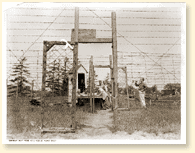

After supper a bugle call announces that the gate is
open for fishing or a walk along the river. Here the camp
spokesmen watch the signing-out and will see that every man
returns. They post their own sentries outside to see that no
one wanders.
Canadian Army Photo |
Life on the Homefront: Axis Prisoners in Canada
Canada was the wartime home to thousands of Allied prisoners-of-war
and internees. Great Britain, faced with a possible invasion by
Hitler, asked Canada in June 1940 to accept 4,000 civilian internees
and 3,000 German prisoners of war. By October 1944, nearly 34,000
military prisoners were held in Canada, many of them in remote camps
in northern Ontario and Quebec and in the Rocky Mountains. Some of
the prisoners cut timber and pulpwood for a small wage, and others
assisted farmers in the more populated parts of the country. Prisoners taken during the fighting in Europe sometimes had their
hands tied or handcuffed. German
prisoners captured during raids in Europe had their hands bound, and
the Germans answered that by tying and handcuffing Canadian and
British prisoners. From October to December 1942, the Canadian
government handcuffed a number of prisoners in Canada to protest
against similar German actions. This sparked camp riots by prisoners
of war, the most serious in Bowmanville, Ontario. Companies of the Veterans Guard of Canada, a force mainly made up of
First World War soldiers, guarded the camps. There were a number of
escapes, but most prisoners were soon found and re-captured. Those
who died in accidents or from illness were buried in Canada. In 1945
the prisoners were returned to their homes, some later returning to
Canada as immigrants. Related Newspaper Articles
English Articles
French Articles
-
L'ennemi et le sujet ennemi
Le Devoir, 07/03/1940
-
Le Canada recevra les étrangers et les prisonniers de guerre allemands internés en Grande-Bretagne
Le Devoir, 20/06/1940
-
Les prisonniers allemands
Le Devoir, 02/07/1940
-
"6,700 prisonniers de guerre et internés"
Le Devoir, 11/07/1940
-
Un prisonnier allemand s'évade d'un camp ontarien
Le Devoir, 20/08/1940
-
"8,000 prisonniers et internés se trouvent dans les camps de concentrationdu Canada"
Le Devoir, 22/08/1940
-
Comment sont traités les prisonniers de guerre dans nos camps d'internement
Le Devoir, 06/09/1940
-
Les règlements de la défense
Le Devoir, 21/11/1940
-
On sera plus prudent à l'endroit des officers capturés
Le Devoir, 28/01/1941
-
Ottawa annonce la capture de 19 des 28 prisonniers nazis évadés vendredi
Le Devoir, 21/04/1941
-
Il y a plus de trois millions de prisonniers de guerre
Le Devoir, 10/07/1941
-
Prionniers nazi capturé par trois aviateurs en Ontario
Le Devoir, 27/02/1942
-
Deux prisonniers allemands se sont évadés
Le Devoir, 17/04/1942
-
Prionniers de guerre arrivés au Canada
Le Devoir, 08/06/1942
-
Un prisonnier nazi s'évade de Sainte-Anne de Bellevue
Le Devoir, 16/07/1942
-
800 marins allemands internés au Canada
Le Devoir, 14/08/1942
-
Le nombre des internés au Canada
Le Devoir, 30/01/1943
-
Camp de prisonniers pour couper du bois de chauffage
Le Devoir, 27/10/1943
-
Deux prisonniers de guerre s'évadent
Le Devoir, 08/07/1944
-
Gros incendie dans un camp d'internement
Le Devoir, 25/09/1944
|